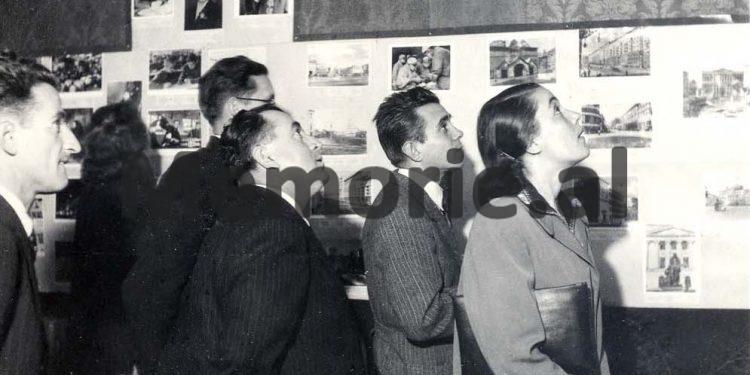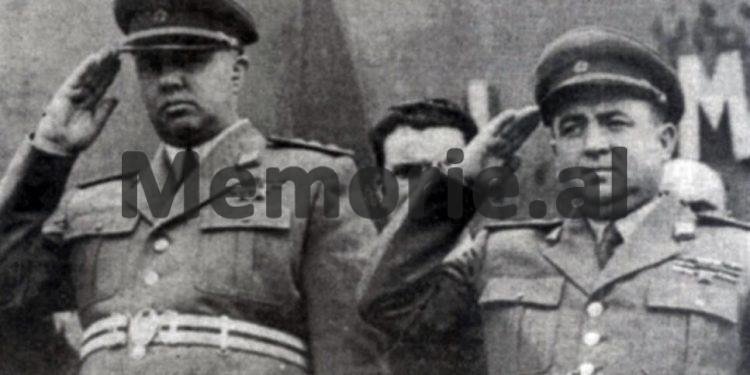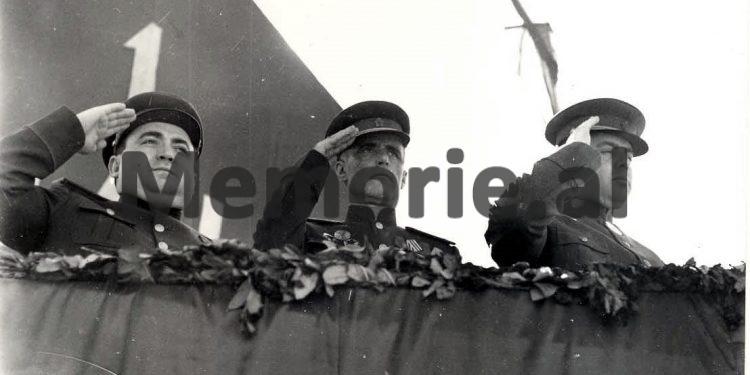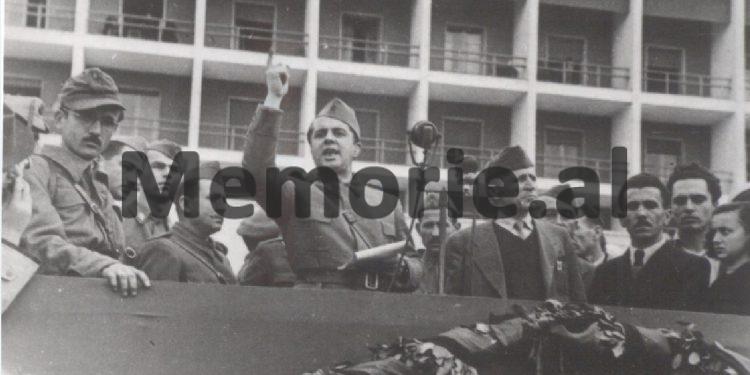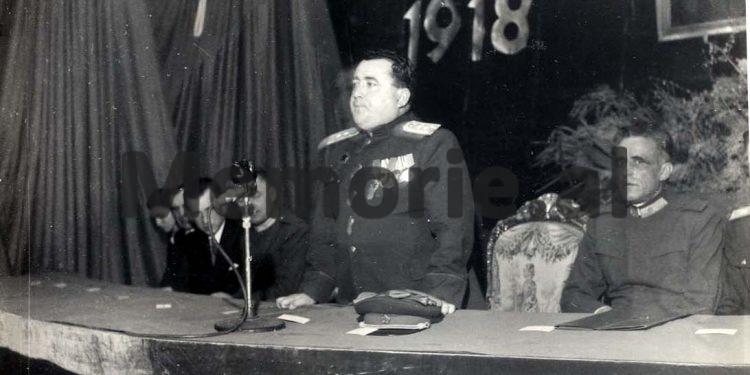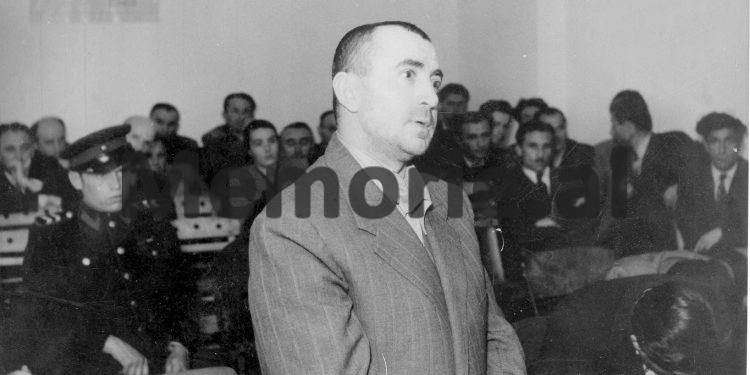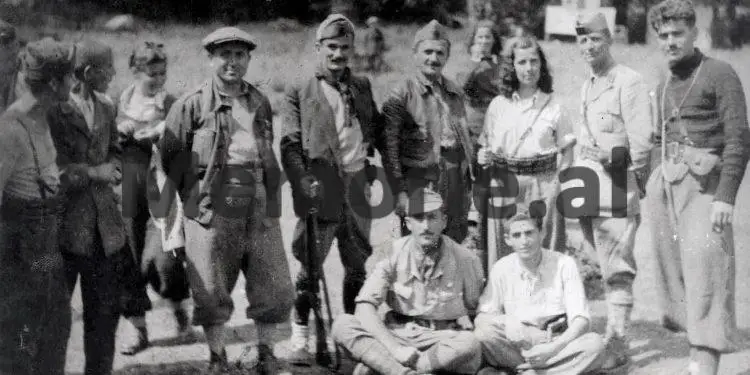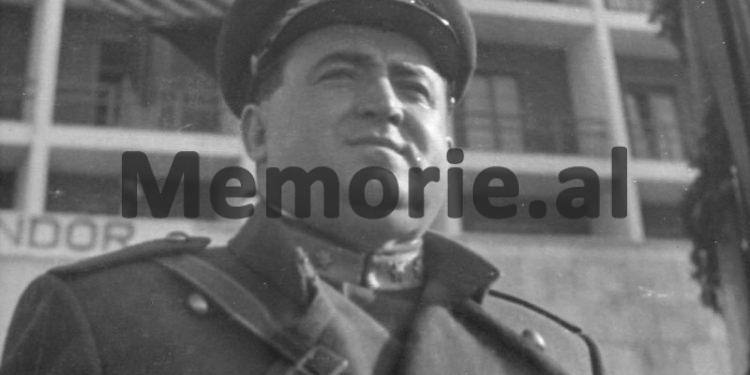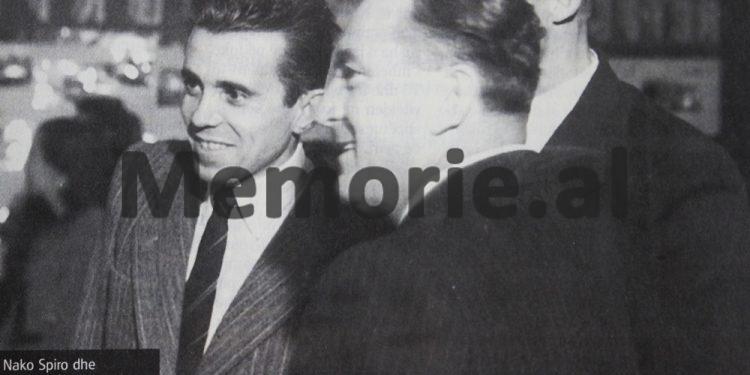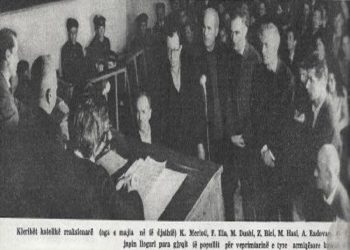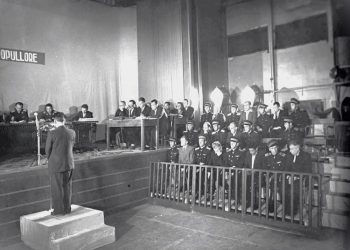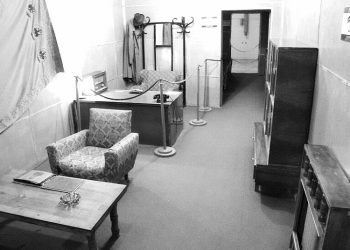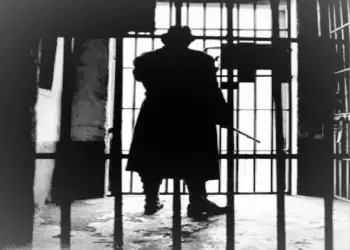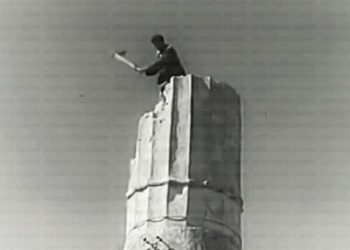Dashnor Kaloçi
The first part
Memorie.al publishes the rare and unknown story of Koçi Xoxe, originally from Cologne, but born in 1911 in the village of Negovan in Florina, Greece, where their family had settled for economic reasons, who after studying and graduating excellently in the classical gymnasium of Thessaloniki in 1929, he returned to the city of Korça, where he became acquainted for the first time with communist ideas and literature, later becoming one of the founders and the first chairman of the Communist Group of Korça since the beginning of 1930s, How he was mandated to attend the founding meeting of the Albanian Communist Party in November 1941, but was arrested by the Italians shortly before that meeting, where he was elected for his great contribution to the communist movement in absentia, as a member of the Provisional Central Committee of the SNP, and then as a member of the General Staff of the National Liberation Army from July 10, 1942, delegate to the Congress of Përmet on May 24, 1944, where he was awarded the rank of neral-major. Xoxa’s brilliant career immediately after the end of the War, climbing the ranks of the party and state hierarchy, as organizational secretary of the Albanian Communist Party, member of the General Presidency of the Democratic Front of Albania, member of the People’s Assembly, Minister of Internal Affairs and Deputy Prime Minister of the ‘democratic government’, being the number two figure of communist Albania, after Colonel-General Enver Hoxha. Unknown photos and rare testimonies of his two sons, Genc and Fatos, who for the first time shed light on the unknown history of their family and father, Koçi Xoxe, his relationship and relations with Enver, as well as the reasons the truth of his beating and physical elimination, as well as their tragic fate after 1949, when he was shot somewhere in a forest on the outskirts of Tirana, where the former Kinostudio “Shqipëria e Re” is, where the remains are still today his!
“After arresting the father, they first took him and isolated him in the basements of the ‘Palace of Brigades’, and after some time they sent him to the New Prison in Tirana, where he was kept under strict security measures, with many police and soldiers. During the investigation, we family could only meet him twice. When we met him for the second time, shortly before he was shot, we were all members of the family, our mother Sofika and her sister, the two sisters Shpresa me Lirë, the older brother Genci, the other brother Çlirimi, me and the younger brother Besniku , which at that time was not more than two months. As I said, I was small then and I do not remember, but as our mother and older brother Genci, who was then 12 years old, told us, before we separated, my father addressed his older brother, saying: Genci do not keep your head down and do not be ashamed that I am here. I have worked and fought for Albania for 20 years and now they are telling me that I made mistakes. But here I am telling everyone, to know that I have not done anything in my head from these accusations, which these raise me. “I have acted in accordance with the decisions of the Politburo and Commander Enver Hoxha.”
This is how Fatos Xoxe remembered the last meeting with his father, Koçi, during the time he was being held in the cells of the New Tirana Prison (known as “Mine Peza” Prison), in April 1949, for a short time. Before he was shot, accused of being an “enemy of the people”, although until his arrest, he was figure no. 2 of the communist regime, holding the highest party and state functions, after Enver Hoxha.
Although he has spent a whole life, full of stress and endless vicissitudes that have not yet been shared, located in an apartment somewhere at the end of Kavaja Street in the capital, since 1991 when they returned from exile, we just told him the purpose of our “visit”, Fatos Xoxe immediately “closed” his business (selling clothes on the sidewalk), and welcomed us with great kindness, even opened his face, probably because it was the first time someone remembered about his father , lieutenant general, Koci Xoxe, the man who until 1949, when he was executed, was considered one of the most powerful people in communist Albania, with an iron power, certainly after Enver Hoxha and sometimes, being a step before or behind him, thanks to the posts of Deputy Prime Minister, member of the Politburo and organizational secretary of the Central Committee of the SNP.
But although he clearly expressed in his portrait a kind of joy for our unexpected ‘visit’, he very kindly, as if not to miss that ‘lucky’ occasion), made it known to us that it was at our disposal, but he had to first inform his older brother, Genc, not only because he knew more about their family history, but also about the fact that since 1949, when they were left without a father, the ‘command’ of the family took Genci and those who from that time obeyed and still respected him, just as if he were their father.
But who was Koçi Xoxe, what was his past, what family background did he come from, where did he study and how did he manage to climb the ladder of power, from the time of the War until 1949, when it seemed that it was consolidating towards the “number one” of communist Albania? Why did his close friendship with Enver Hoxha break down, with whom they did not eat bread without each other, since the houses were adjacent to them and for the two families he cooked the same kitchen and served the same staff!
What were the real reasons that Enver Hoxha hit his subordinate and his closest friend, eliminating him even physically?! Are the serious accusations leveled against Xoxa, for almost 40 years, from the propaganda and historiography of the communist regime and personally of Enver Hoxha, who accused his aide and closest collaborator, as: “the darkest man in history of Albania and an agent of the Yugoslavs, who had the support of Tito”?
Is Koçi Xoxe really responsible for the savage communist terror that took place during the years 1945-1948, when he was in the post of Minister of Interior, where a large part of Hoxha’s close associates were eliminated or physically disappeared, not to mention here opponents of the other political wing, (members of the nationalist organization ‘Balli Kombëtar’, ‘Legality’, etc.), or Xoxe has simply been a staunch executor of his boss in all those crimes, as has happened everywhere in all dictatorships and the countries of the Communist East?
Too many of these questions, members of Koçi Xoxa’s family, such as his wife Sofika, (at the time close to the 90s and with a brilliant memory), as well as her six children, do not give a definite answer. Not that they do not know, or that they do not want, but perhaps also from a trust of their father, who left them before they shot him, saying: “Only history will speak for me”!
This prompted them to adhere to his “legacy”, but despite the attitude of the Xoxe family, archival documents released after the 1990s by the Central State Archive and the archives of the former State Security, (some of which which we will publish in facsimiles in this series of articles about Koci Xoxen), as well as unknown photos that best prove his activity and contribution during the War, which were never published by the propaganda and historiography of the communist regime before the years The ’90s shed light on the numerous forgeries that have been made against his person, accusing him of many crimes committed in a period of time when he had not yet assumed the post of Minister of the Interior!
The origin of the Xoxe family?
Koçi Xoxe was born on May 1, 1911, in the village of Negovan in Florina, Greece, and his mother’s name was Vasillo. According to the testimonies of the family but also of Koçi’s father, Dhimitër Xoxe (or as his nephews called him, Barba), who was born in 1883 and lived in Tirana with his nephews until 1971, the Xoxe family is originally from Cologne. But for economic reasons, like many other families of that province, the Xoxe family moved from their lands, settling first in the village of Pilkat and then in Negovan.
According to documents recently found in the archives of the Hellenic state administration, from Besnik (the youngest son of the family), the trunk of the Xoxe tribe since Koçi’s great-grandfather has been recorded in Greek Church documents since 1841. Grandfather Koçi’s name was Sotir Xoxe and he was the man who opened the first Albanian school in his native village in Negovan. Sotiri was both a ‘dhaskal’ teacher and the chairman of Negovan’s elders.
According to many testimonies, but also archival documents of the Albanian state, Sotir Xoxe (Barba) had a significant patriotic activity and he participated in the Congress of Manastir in 1908, where the Alphabet of the Albanian Language was finally signed. In the 1930s, the family of Sotir Xoxa (Koçi’s grandfather) moved to Constanta, Romania, where Sotir had run the “Dituria” printing house, which he owned. After the ’90s, Koçi’s sons found in Greece the administrative documents of their grandfather, Sotir, and the power of attorney proving the properties of the Xoxe family, as well as the church documents and the birth certificate and the baptismal document of their father, Koçi. .
Koçi Xoxe’s childhood and schooling?
According to the testimonies of his family, Koçi grew up and was educated under the care of his grandfather Sotir, who had that weak point and devoted most of his time to it. After finishing the first six grades in his native village of Negovan, he was then sent to continue his studies at the Thessaloniki Classical Gymnasium, one of the most popular schools in the Balkans at the time, after the “Zosimeas” of Ioannina. Koçi was one of the most distinguished students in his class, both in lessons and very correct in behavior and society.
According to the testimonies of family members, but also of some other contemporaries still living in Greece (who testified to their eldest son, Genc), Koçi was a very intelligent man by nature and he spent almost all his time on books, not only during the school years, but also after he finished it. Ever since he was on the benches of the Thessaloniki classical gymnasium, he read books in Albanian and Greek and spoke Albanian, Greek, Bulgarian and Romanian fluently. According to Genc’s testimonies, Koçi’s former schoolmates told him that Koçi, in addition to being an excellent student, was also a good athlete, especially distinguished as a talented footballer, with the Negovan team, which at that time was led and sponsored by a wealthy fellow villager, with the surname Kacaranxa.
Who was Koçi Xoxe?
He was born in 1911 in the village of Negovan in Florina, but the origin of the Xoxe family is from Cologne. He studied and graduated with honors from the classical gymnasium of Thessaloniki in 1929. Founder and first Chairman of the Communist Group of Korça.
Mandated by the Communist Group of Korça to participate in the founding meeting of the Albanian Communist Party, on November 8, 1941, but arrested by the Italians a few days before that meeting. He is elected in absentia a member of the Provisional Central Committee of the founding meeting of the Albanian Communist Party. Arrested and imprisoned by the Italians in 1942, accused of being anti-fascist.
He was elected a member of the General Staff of the National Liberation Army since July 10, 1942. He was promoted to lieutenant general at the Congress of Përmet on May 24, 1944. He was appointed President of the Supreme Court in February 1945, and presided over the Special Court against the so-called “War criminals” in February-March of that year. Appointed Deputy Prime Minister and Minister of Internal Affairs in 1945. Elected Member of the People’s Assembly in the first legislature in 1945 and member of the General Presidency of the Democratic Front of Albania.
Elected organizational secretary of the Central Committee of the Communist Party of Albania in 1945. Appointed Minister of Industry and Mining in 1948. Decorated ‘People’s Hero’ and with the highest medals in Albania until 1948 and also decorated with many orders and high medals from Bulgaria, Yugoslavia, the Soviet Union, etc.
He was arrested on November 28, 1948 and sentenced to death and shot in May 1949, burying him somewhere in a forest on the outskirts of Tirana, where today is the former Kinostudio “Shqipëria e Re”.
Foreign languages he knew: Latin, Greek, Bulgarian, Italian, Romanian, Serbo-Croatian and French. When he was shot he was 38 years old, married and with six children. It is still unknown where his burial place is. Memorie.al
The next issue follows




